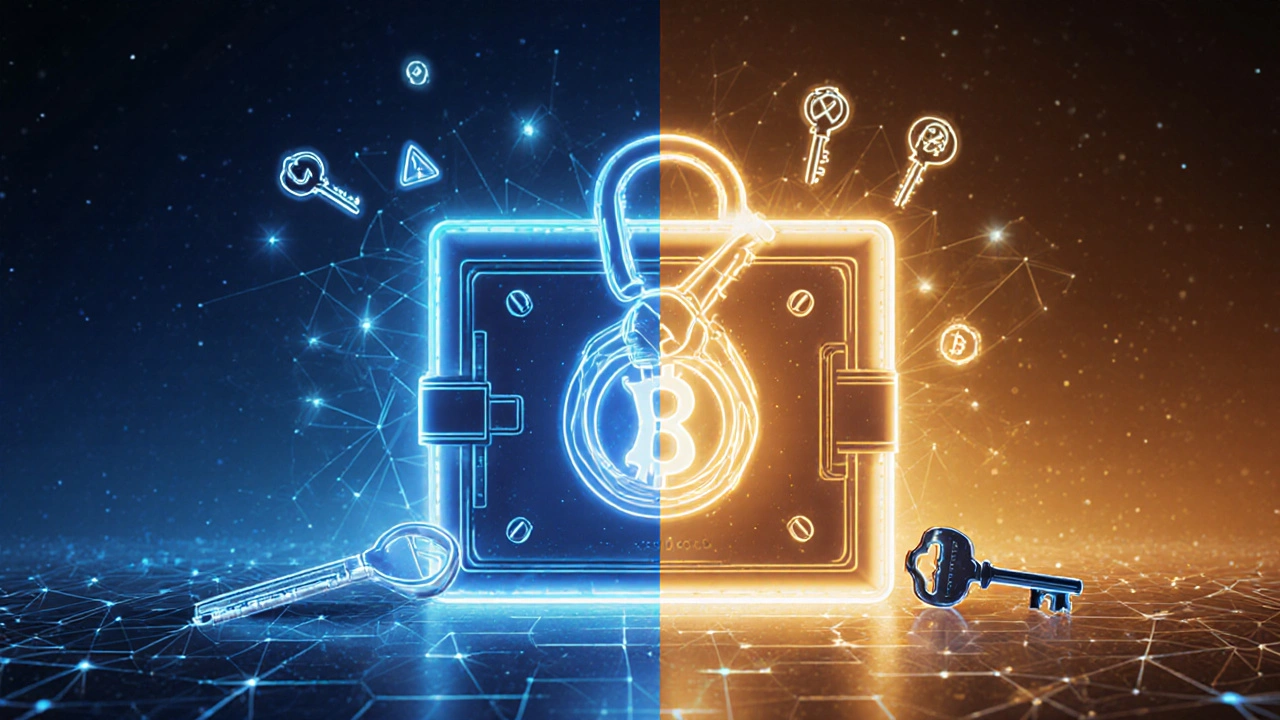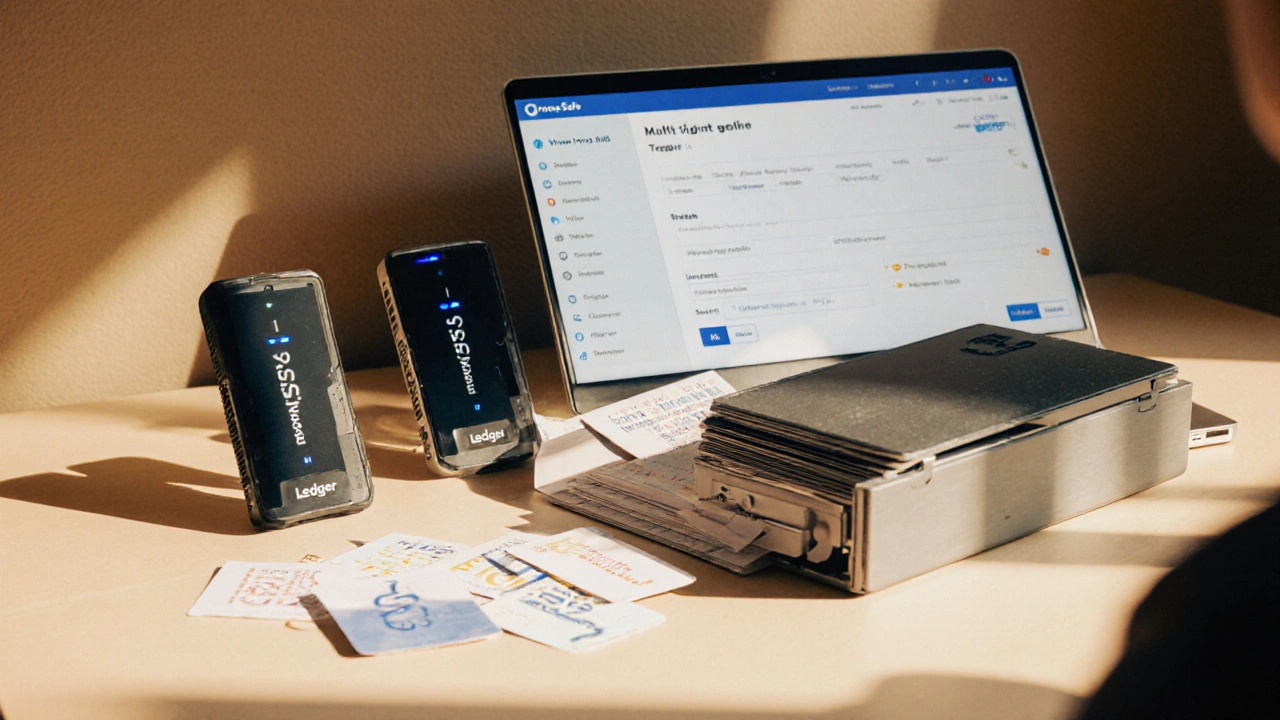Understanding Multi‑Signature Wallets in Crypto - A Beginner’s Guide

Ever wondered why a single lost key can empty a crypto stash in seconds? That nightmare drives many to look for a safer way to hold digital assets. The answer often lands on a multi signature wallet - a setup that spreads control across several keys so no single person can move funds alone.
Key Takeaways
- Multi‑signature wallets requireMout ofNkeys to approve a transaction, dramatically reducing theft risk.
- They work on any blockchain that supports programmable validation, especially Bitcoin and Ethereum.
- Common setups include 2‑of‑3 for families or 3‑of‑5 for DAOs, balancing security and convenience.
- Setting one up involves choosing a platform, generating keys (ideally on hardware devices), and defining the signature threshold.
- Best practices focus on key backup, hardware isolation, regular testing, and monitoring smart‑contract code for bugs.
What Is a Multi‑Signature Wallet?
Multi‑Signature Wallet is a cryptocurrency wallet that requires multiple private keys to authorize a transaction. Instead of a single private key holding the entire authority, the wallet distributes control across several keys, often held by different people or devices. This concept mirrors a joint bank account where two signatures are needed to withdraw cash.
How Does It Work?
At its core, a multi‑signature wallet follows an M‑of‑N rule:
- Generate N distinct Private Keys, each linked to a public address.
- Define M, the minimum number of signatures required to validate a transaction.
- When a user initiates a transfer, the transaction is broadcast to the network with a special script (for Bitcoin) or a smart contract (for Ethereum) that checks for M valid signatures.
If the network receives the required signatures, the transaction is considered legitimate and is executed. If not, it remains locked.
Why Use a Multi‑Signature Wallet?
Security is the headline benefit. A thief would need to steal not just one key but enough of them to meet the threshold. That dramatically raises the cost and complexity of an attack.
Beyond security, multi‑signatures enable shared governance. Teams can manage a treasury, families can set up heir‑accessible funds, and exchanges can separate hot and cold storage with different approval layers.
Regulatory compliance also becomes easier. Some jurisdictions require dual‑control for custodial services, and a multi‑signature scheme satisfies that requirement without handing over custody to a third party.

Common Use Cases
- DAO Treasuries: A Decentralized Autonomous Organization often adopts a 3‑of‑5 or 5‑of‑7 model so that decisions need broader consensus.
- Family Savings: Parents can set a 2‑of‑3 wallet with their own two keys and a backup key stored with a trusted relative.
- Exchange Hot Wallets: A crypto exchange may require two senior staff signatures and one hardware‑wallet signature before moving large amounts.
- Institutional Custody: Hedge funds use multi‑signature vaults to meet internal risk policies and auditor requirements.
Step‑by‑Step: Setting Up a Multi‑Signature Wallet
Below is a practical walkthrough using two popular tools: Gnosis Safe on Ethereum and Electrum for Bitcoin.
- Choose the platform. Gnosis Safe offers a web UI and mobile app; Electrum provides a lightweight desktop client.
- Create N keys. For highest security, generate each key on a separate hardware device (e.g., Ledger, Trezor). Record the seed phrases in secure, offline locations.
- Define the threshold M. A common balance is 2‑of‑3 for personal use or 3‑of‑5 for organizational use.
- Deploy the wallet. In Gnosis Safe, click “Create new Safe,” input the owners’ addresses, and set the required confirmations. In Electrum, select “Multi‑sign” during wallet creation and enter the public keys.
- Test with a small transaction. Send a tiny amount of ETH or BTC to the new wallet, then attempt a transfer requiring M signatures. Verify that each signer can approve via their device.
- Back up the configuration. Export the wallet’s descriptor (Electrum) or safe address and owner list (Gnosis). Store these backups in encrypted, offline media.
Once the test passes, you can start using the wallet for larger amounts, confident that no single compromised key can drain the funds.
Best Practices for Maintaining a Multi‑Signature Wallet
- Use hardware wallets for every private key. This isolates keys from malware on computers.
- Distribute backups geographically. Keep seed phrases in fire‑proof boxes in different locations.
- Rotate keys periodically. Replace old hardware devices every 2‑3 years to mitigate wear‑related failures.
- Document the signing process. Write clear SOPs so that new team members can follow the approval workflow without guesswork.
- Monitor smart‑contract code. For Ethereum‑based multisig wallets, stay updated on security audits and fork patches.
- Set reasonable thresholds. Too high a M value can cause delays; too low a value reduces security.
Comparison: Custodial vs. Non‑Custodial vs. Multi‑Signature
| Feature | Custodial | Non‑Custodial | Multi‑Signature |
|---|---|---|---|
| Key control | Provider holds keys | User holds a single key | Multiple users hold separate keys |
| Security model | Trust the provider’s security | Security hinges on one key | Compromise requires M keys |
| Recovery options | Provider can reset access | Only seed phrase restores | Backup of each key needed |
| Regulatory compliance | Usually compliant (KYC/AML) | Self‑custody, less regulated | Can satisfy compliance with audit trails |
| Usability | Simple UI, instant withdrawals | Easy for small amounts | Extra steps for each transaction |
Potential Pitfalls and How to Avoid Them
Key loss. If enough keys are lost, the funds become irretrievable. Mitigate by backing up each seed phrase and using hardware wallets with battery‑backed secure elements.
Coordination delays. Requiring three signatures can slow down emergency withdrawals. Choose an M value that matches your risk appetite and operational speed.
Smart‑contract bugs. On Ethereum, many multisig wallets are implemented as contracts. A coding flaw can freeze assets. Stick with audited contracts like Gnosis Safe or the native Bitcoin P2WSH script.
Higher transaction fees. Multi‑sig scripts add extra data, resulting in larger transaction sizes and higher network fees, especially on Bitcoin. Plan for this by budgeting extra satoshis or gas.
Future Trends: Account Abstraction and Smart‑Contract Wallets
Developers are building Account Abstraction solutions that embed multi‑signature logic directly into a user’s wallet contract, allowing custom verification (e.g., biometric, social recovery). This could make multi‑sig wallets more user‑friendly without sacrificing security.
Layer‑2 networks like Optimism and Arbitrum also support cheaper multi‑sig contracts, opening the door for everyday DeFi users to protect larger balances without paying Bitcoin‑level fees.
Quick Checklist Before You Deploy
- Identify N participants and generate N hardware‑backed keys.
- Decide on an M threshold that balances security and speed.
- Choose a reputable platform (Gnosis Safe, Electrum, Sparrow).
- Test with a minimal transaction on the target blockchain.
- Document recovery procedures and store backups offline.
Frequently Asked Questions
What is the difference between a multi‑signature wallet and a regular wallet?
A regular wallet is controlled by a single private key. A multi‑signature wallet requires M out of N separate keys to approve every transaction, adding a layer of collective security.
Can a multi‑signature wallet be used on any blockchain?
Most blockchains that support programmable scripts or smart contracts-such as Bitcoin, Ethereum, Binance Smart Chain, and Solana-allow multi‑signature setups. The exact implementation varies (script vs. contract).
How many keys should I use?
It depends on your use case. For personal savings, 2‑of‑3 is common. For organizations, 3‑of‑5 or 5‑of‑7 balances security with operational efficiency.
What happens if I lose one of my keys?
If the lost key is not part of the required M signatures, the wallet still works with the remaining keys. However, you should replace the missing key as soon as possible to maintain the original security level.
Are multi‑signature wallets more expensive to use?
Transaction sizes are larger because they carry multiple signatures, which can raise network fees. On Bitcoin, this might mean a few extra satoshis per byte; on Ethereum, gas costs increase modestly.





